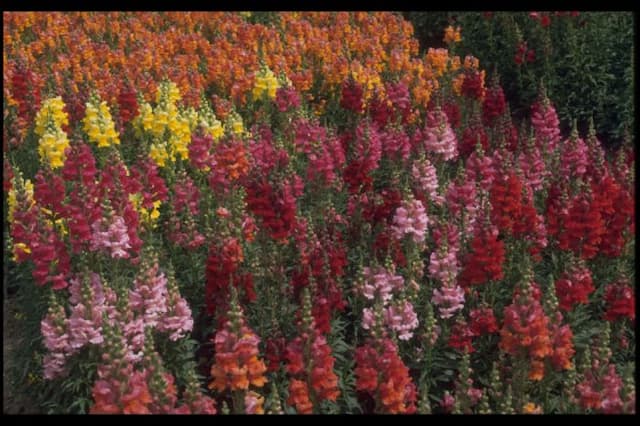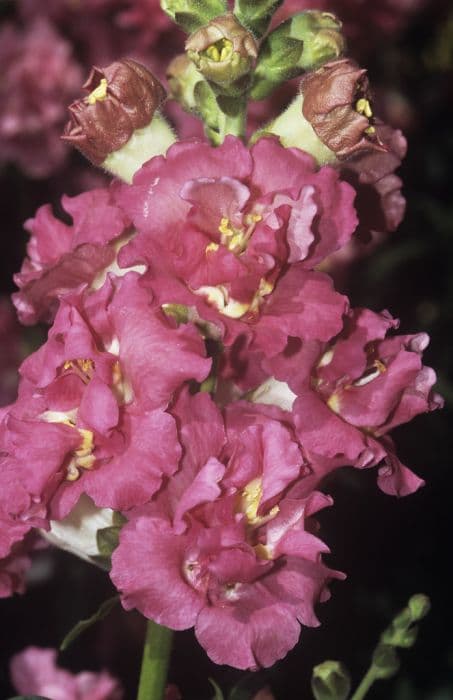Mountain Pride Penstemon newberryi

ABOUT
Penstemon newberryi, commonly known as Mountain Pride, is a showy perennial that boasts vibrant flowers and attractive foliage. The plant has a bushy habit, with stems that are often woody at the base. The leaves are glossy, green, and predominantly lance-shaped, with a smooth or slightly serrated edge. They are arranged alternately along the stems, giving the plant a lush, full appearance. The standout feature of Mountain Pride is its striking flowers, which bloom in clustered whorls. Each tubular flower has a flared mouth, resembling an open bell. The blossoms are typically vivid pink to magenta in color, with some varieties displaying a gradient of shades or streaks of white. The flowers have a prominent lower lip that is often lobed, adding to their ornamental appeal. Mountain Pride's bloom time usually occurs in late spring to early summer, during which the plant is alive with color and can attract pollinators such as bees and hummingbirds. The flower stalks rise above the foliage, creating an eye-catching display against the green leaves. After the blooming period, the plant produces capsule-like fruits containing small seeds. This plant adds a burst of color to rock gardens, alpine collections, or borders. Its tolerance for various growing conditions makes it a versatile choice for gardeners looking to incorporate native, drought-tolerant species into their landscapes.
About this plant
 Names
NamesFamily
Plantaginaceae.
Synonyms
Mountain Pride, Newberry's Penstemon, Pride of the Mountain.
Common names
Penstemon newberryi var. berryi, Penstemon newberryi var. newberryi, Penstemon newberryi var. sonomensis.
 Toxicity
ToxicityTo humans
Mountain Pride (Penstemon newberryi) is generally not considered toxic to humans. There is no significant evidence or widespread reports of toxicity from the ingestion of this plant. As with any plant, individual sensitivities may vary, and it is always advisable to seek medical advice if any adverse reactions are observed after ingestion.
To pets
Mountain Pride (Penstemon newberryi) is not known to be toxic to pets. This plant is not listed among those commonly known to cause poisoning in animals such as dogs or cats. However, as with humans, individual animals may have different sensitivities, and it is always best to prevent pets from ingesting plants. If you suspect your pet has eaten any part of this plant and is showing unusual symptoms, consult your veterinarian.
 Characteristics
CharacteristicsLife cycle
Perennials
Foliage type
Evergreen
Color of leaves
Green
Flower color
Pink
Height
1-2 feet (0.3-0.6 meters)
Spread
1-2 feet (0.3-0.6 meters)
Plant type
Herb
Hardiness zones
5
Native area
California
Benefits
 General Benefits
General Benefits- Attracts Pollinators: Penstemon newberryi, commonly known as mountain pride, is known to attract bees, butterflies, and hummingbirds, promoting pollination in gardens.
- Ornamental Value: With its showy pink to magenta flowers, mountain pride can add aesthetic appeal to landscapes and decorative gardens.
- Drought Resistance: As a native of dry mountainous regions, it is well adapted to low-water conditions, making it suitable for xeriscaping and sustainable gardens.
- Erosion Control: This plant has a fibrous root system that helps to stabilize soil and prevent erosion on slopes and banks.
- Native Habitat Support: By including Penstemon newberryi in gardens, gardeners can help to support and maintain local biodiversity and native ecosystems.
- Wildlife Food Source: The nectar-rich blooms provide a valuable food source for a variety of wildlife, especially native pollinators at higher elevations.
 Medical Properties
Medical PropertiesThis plant is not used for medical purposes.
 Air-purifying Qualities
Air-purifying QualitiesThis plant is not specifically known for air purifying qualities.
 Other Uses
Other Uses- Wildlife Habitat: Mountain Pride can provide a valuable habitat for certain wildlife species, including nesting sites for native bees and other pollinators.
- Erosion Control: The plant's ability to grow in rocky or loose soil makes it useful for stabilizing slopes and preventing soil erosion in mountainous areas.
- Ornamental Use: Mountain Pride is often grown in rock gardens or as a border plant for its vibrant flowers and attractive foliage.
- Dye Production: The flowers or leaves might be used in traditional practices to create natural dyes for textiles or crafts, although this use is not well-documented.
- Educational Tool: It can serve as a candidate for botanical studies or educational programs focused on native flora and plant reproduction.
- Garden Biodiversity: Incorporating Mountain Pride can increase the biodiversity of a garden, supporting the overall health of the garden ecosystem.
- Photography Subject: Its striking flowers make it a favorite subject for nature photographers and plant enthusiasts.
- Culinary Garnish: Although not typically consumed, the bright flowers could be used to add visual appeal as a non-toxic garnish for culinary dishes.
- Aromatic Qualities: While not strongly scented, the foliage may have a mild aroma that can add a subtle fragrance to gardens or floral arrangements.
- Crafts and Floral Arrangements: The stems and flowers can be used in crafting, such as making pressed flower bookmarks, cards, or for adding a natural touch to floral arrangements.
Interesting Facts
 Feng Shui
Feng ShuiMountain Pride is not used in Feng Shui practice.
 Zodiac Sign Compitability
Zodiac Sign CompitabilityMountain Pride is not used in astrology practice.
 Plant Symbolism
Plant Symbolism- Resilience: Penstemon newberryi, commonly known as Mountain Pride, often grows in rocky and challenging mountain terrains, symbolizing the ability to thrive in difficult conditions.
- Beauty in Harshness: With its vibrant colors and distinctive shape, Mountain Pride represents the concept of finding and celebrating beauty in harsh or unexpected places.
- Adaptability: As a plant that can adapt to various altitudes and climates, Mountain Pride symbolizes flexibility and the capacity to adjust to changing environments.
- Vibrancy: The striking blooms of the Mountain Pride plant are a symbol of vibrancy and the richness of life, encouraging an appreciation for the vivid moments.
- Endurance: Mountain Pride's ability to survive winter and bloom again is symbolic of endurance and the persistence to overcome obstacles over time.
 Water
WaterMountain Pride, commonly known as Penstemon newberryi, should be watered deeply to ensure the soil is moist but not waterlogged. During the growing season, watering once a week with about 1 inch of water, or approximately 0.6 gallons per square yard, is sufficient. In hotter, drier periods, increase the frequency to twice a week, making sure that the water penetrates deeply into the soil to encourage deep root growth. Reduce watering in the fall and water sparingly in winter, only enough to prevent the soil from drying out completely. Always check the soil moisture before watering to avoid overwatering, which can lead to root rot.
 Light
LightMountain Pride prefers full sun to partial shade conditions. It thrives best in a location where it can receive at least 6 hours of direct sunlight daily. However, in extremely hot climates, a spot with afternoon shade can protect the plant from excessive heat. Avoid deep shade, as this can reduce flowering and cause the plant to become leggy.
 Temperature
TemperatureMountain Pride is best suited to temperatures that mimic its native mountainous conditions. It can withstand temperatures down to about 20 degrees Fahrenheit during its dormant winter phase. During the growing season, Mountain Pride prefers average to warm temperatures, ideally between 60 and 85 degrees Fahrenheit. However, it is adaptable and can tolerate occasional temperature spikes above this range.
 Pruning
PruningMountain Pride should be pruned to remove spent flower stalks and encourage a second bloom. Pruning is also necessary to maintain plant shape and remove any dead or damaged foliage. The best time to prune is immediately after the first flush of flowers fades, typically in mid to late summer. Pruning in early spring can also help to invigorate the plant and promote healthier growth.
 Cleaning
CleaningAs needed
 Soil
SoilMountain pride (Penstemon newberryi) prefers well-draining soil with a gritty or sandy texture. A suitable mix would be one part potting soil, one part coarse sand or perlite, and a small amount of compost. The ideal pH for mountain pride is slightly acidic to neutral, ranging from 6.0 to 7.0.
 Repotting
RepottingMountain pride generally does not require frequent repotting. It can be repotted once every 2 to 3 years, or as needed when the plant outgrows its container. Ensure to use a well-draining soil mix when repotting.
 Humidity & Misting
Humidity & MistingMountain pride is adaptable to a range of humidity levels but prefers moderate humidity. No specific humidity level is prescribed, but avoid extremely high humid conditions to prevent fungal issues.
 Suitable locations
Suitable locationsIndoor
Provide bright light and well-draining soil.
Outdoor
Plant in well-draining soil; full sun to part shade.
Hardiness zone
5-8 USDA
 Life cycle
Life cyclePenstemon newberryi, commonly known as mountain pride, begins its life as a seed, typically requiring a period of cold stratification to break dormancy. Upon germination in late winter or early spring, the seedling establishes itself, developing a root system and foliage. As it matures into a vegetative plant, it develops a rosette of leaves at the base. Flowering occurs from late spring to midsummer, producing vivid tubular flowers that attract pollinators. After pollination, the flowers develop into fruit capsules containing numerous small seeds. The plant may die back to the ground in the winter, especially in colder climates, but it is a perennial and will regrow from the base the following growing season.
 Propogation
PropogationPropogation time
Spring to Summer
Propogation: The most popular method of propagating Penstemon newberryi, commonly known as mountain pride, is through seed sowing. The optimal time for sowing seeds is late winter to early spring, shortly before the last frost, when temperatures are cool enough to facilitate germination. To propagate, one needs to scatter the seeds on the surface of a well-draining soil mix and lightly press them into the medium without covering them, as they require light for germination. The container should be kept moist and in a bright area without direct sunlight. Germination typically occurs within 2 to 4 weeks. After seedlings have developed a few sets of true leaves, they can be transplanted into individual pots or outdoor settings, making sure to harden them off to prevent shock from the outdoor environment.





![Snapdragon [Pretty in Pink]](/_next/image?url=https%3A%2F%2Fplants-admin.emdemapps.com%2Fimages%2Fplants%2F%2Fimages%2F604b5cb3b5385.png&w=640&q=75)



